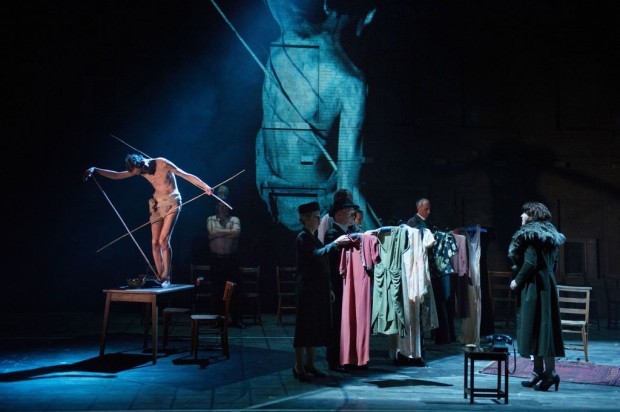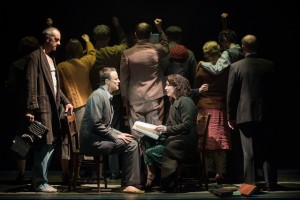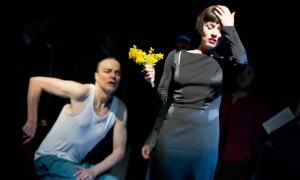You have no items in your cart. Want to get some nice things?
Go shopping
As novels go, Mikhail Bulgakov’s The Master and Margarita does not scream out to be adapted for theatre. Set partly in Stalinist Moscow and partly in Biblical Judea, it opens with the Devil (in the guise of “Professor” Woland; think “Roland” with a lisp) interrupting a discussion on atheism between a poet, Ivan, and the Chairman of MASSOLIT (the soviet party-line Arts whipping boys), named Berlioz. The Devil’s havoc is immediate. Berlioz is run over by a tram, Ivan is incarcerated in an asylum, and soon the Devil and his colourful retinue have taken up residence in Berlioz’s apartment and are preparing to put on a night of black magic at a Moscow theatre.
There is enough substance here for perhaps four separate plays, yet we have only really scratched the surface because what the book actually turns to focus on next is the man Ivan meets at the asylum. He is another writer, this time known simply as the Master, whose novel depicting the trial of Jesus was deemed too real and too sentimental for the atheist MASSOLIT. The Master however, has his muse: a striking woman, though married, called Margarita, who, having lost her love to the state, enters into a Faustian pact with the Devil. Woland agrees to reunite her with the Master so long as she helps him out by greeting all of the guests at the Satanic ball he is holding in Berlioz’s apartment. In the midst of Margarita’s games with the Devil, and the Master’s and Ivan’s attempts to make sense of their incarceration, we are regularly catapulted back nearly 2,000 years to the scene which got both of these writers into trouble: namely the trial of Yeshua (Jesus).
Confused yet? You should be. You have every right to be. To read, The Master and Margarita is a stunning yet at times bewildering novel. The very fact that it has ever been adapted for the stage is worthy of applause. That this adaptation at the Barbican Theatre covers not only every aforementioned scene but a whole host of other ones that have been skated over — in just three hours — is worthy of an ovation. That it may well be a triumph makes me go weak at the knees.

If any theatre company were to pull off this Master and Margarita coup it would be Complicite under the direction of Simon McBurney. Founded in 1983, Complicite have spent the last thirty years building a reputation for innovative and ground-breaking theatre and Simon McBurney describes Complicite rehearsals as involving “constant fooling around”, with an “immense amount of chaos”. Their creative process is a constructive one, continually working on the project even up until the final night — in a manner not dissimilar to Mikhail Bulgakov himself, who continued to redraft his novel up until his death in 1940. The most immediately striking aspect of their production is that, in a tale where the Devil treats the Muscovites to his black magic trickery, this is a performance of immense theatrical virtuosity.
Despite opening simply with a single line of chairs on an empty stage, Complicite soon demonstrate their ability: apartments, hospital wards, trams and Pilate’s court are all created with little more than four lines of white light and a chair. A single upright booth plays kiosk, tramcar, box office and the threshold of hell. When Ivan looks out of a window he simply lifts up the stick held by another character from out of the shadows. At one point all sixteen chairs are held aloft by the cast to provide the olive grove of Gethsemane, before being rocked loudly against the floor to introduce a running horse. Nothing is static. Scenes are convoluted into one another with the actors from the previous action holding together the newly located set.
But this is the straightforward stuff. More complex is Complicite’s use of video, which is regular and inventive and worthwhile. Clever camera work allows heads to be severed, Margarita to fly, and Yehuda (Judas) to hang. During Pilate’s deliberation the tension in his jaw is cast across the back curtain and at one point Berlioz’s head is projected onto a mannequin so the Devil can strike it in two with a meat cleaver. Street maps of Moscow are projected onto the stage and exited with a Google Earth-esque zoom. Judea is suggested through pillars, Russian crowds and street mobs look on from the back wall, bees swarm and buzz. Video trickery allows the Master and Margarita to fly across the back wall on a horse made from animated chairs. On the night of Woland’s black magic performance we, the audience, found ourselves emblazoned across the back curtain, with the actors standing looking out amongst us, goading us to look ourselves up and down in a sort of narcissistic reversal that felt like it went on far too long.

The actors themselves move in bizarre and convoluted ways: the Master limps; Woland struts; Azazello dances; Koroviev slithers; Behemoth, brought to life as a giant puppeted tom-cat lurches aggressively across the stage — he spits profanities with such histrionics as to suggest that the huddled puppeteers who direct him are themselves unsure as to who is in control. In contrast, Yeshua is emaciated and looks close to death even before he is crucified with three carefully placed bamboo canes. Pilate’s proud stance is checked by a wince that suggests a dull and nagging ache. Rather than deal out a series of creaking Russian accents, characters assume a variety of voices: members of MASSOLIT speak as if they are at a Rotary Club meeting in Halifax; Yeshua’s delivery has a Mexican lilt reminiscent of El Nombre (a Zorro-type character who teaches children how to add up); Woland picks up a childish sneer and never lets go of it; Behemoth assumes the persona of a hyper-aggressive wide boy; and for some unknown reason, Azazello is American.
To see all this written down it all begins to seem farcical. In many respects it is. Large sections of what happens on stage are ridiculous. The production is overblown. It is theatrical. Surely farce is intended. As an audience we are constantly being asked to question what, if indeed anything, is real about this performance. When the Master fusses outside Berlioz’s MASSOLIT office the receptionist’s patience blows and she tells him to walk on through because “there is nothing there”. Later when the Master and Margarita are back in the Master’s apartment, following Margarita’s pact with the devil, he argues with her for believing that the place they have been returned to even exists. “None of this is real,” he rages, at the moment when the actors who hold the set together in the shadows fall over, taking the chairs and thus the room with them. This is the Devil’s work, the Master is saying, it is theatre, it is light and camera and action. It is not real.
In the play’s opening scene Berlioz explains to the poet Ivan that the problem with his new poem — another revisiting of Pilate and the trial of Jesus — is that he has made the character of Jesus too believable. To the atheist MASSOLIT chairman, who believes in the Soviet ideals of man and his achievements alone, this is ridiculous. To quote Bulgakov’s original, Berlioz “wanted to prove to the poet that the main point was not whether Jesus had been good or bad, but that he had never existed as an individual, and that all stories about him were mere inventions.” For large portions of the Master and Margarita inventiveness is all. There is a great desire to show just what can be done on stage in front of an audience. But the same Devil that brings black magic trickery to the stage and projects videos of the audience onto the back curtain also brings the moment when the Master and Margarita meet in a crowded tram car, and the instance in which the sturdy Pilate is taken into the arms of the fragile Jesus. Finally, towards the plays end, after Behemoth has lurched off stage and the chairs have receded, when we are left with Ivan alone in the middle of the empty stage, with no video to complicate the image and no microphone to amplify his voice, he asks simply: “What comes next?” For some, the theatrical mastery of Complicite will be enough; for others, it may be too much. For me, it was the moments of sincere humanity that managed to stand out — those moments when the theatre stepped back and the tale spoke.
The Master and Margarita at the Barbican Theatre closed on 19 January. You can find more information on the theatre company Complicite here.

About Thomas Chadwick
Thomas Chadwick is currently splitting his time between London and Gent, Belgium. His short fiction has been published in print and online and he was shortlisted for the Bridport Prize 2013.




